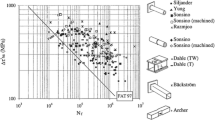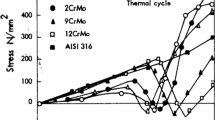Abstract
In this investigation, a T-joint numerical welding simulation of thick steel plates is performed to estimate transient temperature distributions, residual stress field and model deflections. A sequential simulation method is applied in the numerical simulation, where the thermal analysis is done by using the EBD technique to simulate the weld wire melting and metal filler addition while the mechanical analysis is performed in one step without EBD to shorten the calculation time. Thermocouples, non-destructive X-ray diffraction and semi-destructive hole-drilling methods are used to measure the temperature and residual stress distributions. In the thermal analysis, a simplified heat flux is used which causes a relatively large temperature discrepancy in the weld pool area between the numerical and experimental results. The calculated temperature histories outside the weld pool and its vicinity correlate very well with the experimental measurements with an acceptable discrepancy of approximately 4%. The residual stresses are firstly measured on the model surface without electropolishing and then two times after that, at depths of 0.005 and 0.015 mm. The results of residual stress obtained by numerical modelling and measurement with X-ray agree better when the electropolishing removing layer is set to 0.015 mm, due to a significantly smaller effect of surface conditions that originate from steel plate production.



















Similar content being viewed by others
Abbreviations
- U :
-
Welding voltage, V
- I :
-
Welding current, A
- Q :
-
Heat flux, J m−3 s−1
- v :
-
Welding speed, mm/min
- h c :
-
Convective heat transfer coefficient, W m−2 K−1
- ε :
-
Surface emissivity factor
- η :
-
Welding process efficiency
- MAG:
-
Metal active gas
- EBD:
-
Element birth and death
References
Takazawa H, Yanagida N. Effect of creep constitutive equation on simulated stress mitigation behavior of alloy steel pipe during post-weld heat treatment. Int J Press Vessels Pip. 2014;117–118:42–8. https://doi.org/10.1016/j.ijpvp.2013.10.008.
Perić M, Garašić I, Nižetić S, Dedić-Jandrek H. Numerical analysis of longitudinal residual stresses and deflections in a T-joint welded structure using a local preheating technique. Energies. 2018;11(12):3487. https://doi.org/10.3390/en11123487.
Coules HE, Colegrove P, Cozzolino LD, Wen SW. High pressure rolling of low carbon steel weld seams: part 1—effects on mechanical properties and microstructure. Sci Technol Weld Join. 2013;18(1):63–78. https://doi.org/10.1179/1362171812Y.0000000079.
Coules HE, Colegrove P, Cozzolino LD, Wen SW, Kelleher JF. High pressure rolling of low carbon steel weld seams: part 2—roller geometry and residual stress. Sci Technol Weld Join. 2013;18(1):84–90. https://doi.org/10.1179/1362171812Y.0000000080.
Deng D, Liang W, Murakawa H. Determination of welding deformation in fillet-welded joint by means of numerical simulation and comparison with experimental measurements. J Mater Process Technol. 2007;183:219–25. https://doi.org/10.1016/j.jmatprotec.2006.10.013.
Gannon L, Liu Y, Pegg M, Smith M. Effect of welding sequence on residual stress and distortion in flat-bar stiffened plates. Effect of welding-induced residual stress and distortion on ship hull girder ultimate strength. Mar Struct. 2010;23(3):375–404. https://doi.org/10.1016/j.marstruc.2010.05.002.
Keivani R, Jahazi M, Pham T, Khodabandeh AR, Afshar MR. Predicting residual stresses and distortion during multisequence welding of large size structures using FEM. Int J Adv Manuf Technol. 2014;73(1–4):409–19. https://doi.org/10.1007/s00170-014-5833-4.
Li Y, Wang K, Jin Y, Xu M, Lu H. Prediction of welding deformation in stiffened structure by introducing thermo-mechanical interface element. J Mater Process Technol. 2015;216:440–6. https://doi.org/10.1016/j.jmatprotec.2014.10.012.
Rong Y, Zhang G, Huang Y. Study of welding distortion and residual stress considering nonlinear yield stress curves and multi-constraint equations. J Mater Eng Perform. 2016;25(10):4484–94. https://doi.org/10.1007/s11665-016-2259-1.
Perić M, Tonković Z, Rodić A, Surjak M, Garašić I, Boras I, Švaić S. Numerical analysis and experimental investigation of welding residual stresses and distortions in a T-joint fillet weld. Mater Des. 2014;53:1052–63. https://doi.org/10.1016/j.matdes.2013.08.011.
Wang C, Kim YR, Kim JW. Comparison of FE models to predict the welding distortion in T-joint gas metal arc welding process. Int J Adv Manuf Technol. 2014;18(8):1637–931. https://doi.org/10.1007/s12541-014-0513-8.
Tian L, Luo Y. A comparison study of BPN and SVM prediction models for inherent deformations of T-welded joints. Mech Adv Mater Struct. 2019. https://doi.org/10.1080/15376494.2019.1567881(in press).
Tian L, Luo Y. A study on the prediction of inherent deformation in fillet–welded joint using support vector machine and genetic optimization algorithm. J Intell Manuf. 2019. https://doi.org/10.1007/s10845-019-01469-w(in press).
Lostado R, Fernandez Martinez R, Mac Donald BJ, Villanueva PM. Combining soft computing techniques and the finite element method to design and optimize complex welded products. Integr Comput-Aid E. 2015;22(2):153–70. https://doi.org/10.3233/ICA-150484.
Bhatti AA, Barsoum Z, Murakawa H, Barsoum I. Influence of thermo-mechanical material properties of different steel grades on welding residual stresses and angular distortion. Mater Des. 2015;65:878–89. https://doi.org/10.1016/j.matdes.2014.10.019.
Perić M, Tonković Z, Garašić I, Vuherer T. An engineering approach for a T-joint fillet welding simulation using simplified material properties. Ocean Eng. 2016;128:13–21. https://doi.org/10.1016/j.oceaneng.2016.10.006.
Baba H, Era T, Ueyama T, Tanaka M. Single pass full penetration joining for heavy plate steel using high current GMA process. Weld World. 2017;61(5):963–9. https://doi.org/10.1007/s40194-017-0464-7.
Perić M, Garašić I, Tonković Z, Vuherer T, Nižetić S, Dedić-Jandrek H. Numerical prediction and experimental validation of temperature and residual stress distributions in buried-arc welded thick plates. Int J Energy Res. 2019;43(8):3590–600. https://doi.org/10.1002/er.4506.
Pilipenko A. Computer simulation of residual stress and distortion of thick plates in multi-electrode submerged arc welding. Their mitigation techniques. Doctoral Thesis, Trondheim, 2001.
Huang H, Tsutsumi S, Wang J, Li L, Murakawa H. High performance computation of residual stress and distortion in laser welded 301L stainless sheets. Finite Elem Anal Des. 2017;135:1–10. https://doi.org/10.1016/j.finel.2017.07.004.
Lin J, Ma N, Lei Y, Murakawa H. Measurement of residual stress in arc welded lap joints by cosα X-ray diffraction method. J Mater Process Technol. 2017;243:387–94. https://doi.org/10.1016/j.jmatprotec.2016.12.021.
Perić M, Tonković Z, Karšaj I, Stamenković D. A simplified engineering method for a T-joint welding simulation. Therm Sci. 2018;22(3):S867–73. https://doi.org/10.2298/TSCI171108020P.
Seleš K, Perić M, Tonković Z. Numerical simulation of a welding process using a prescribed temperature approach. J Constr Steel Res. 2018;145:49–57. https://doi.org/10.1016/j.jcsr.2018.02.012.
Venkatkumar D, Ravindran D. Effect of boundary conditions on residual stresses and distortion in 316 stainless steel butt welded plate. High Temp Mater Proc. 2019;38:827–36. https://doi.org/10.1515/htmp-2019-0048.
Nasouri R, Nguyen K, Montoya A, Matamoros A, Bennett C, Li J. Thermally-induced demands due to hot dip galvanization of high mast illumination poles. Part I: finite element model development. J Constr Steel Res. 2019;162:105705. https://doi.org/10.1016/j.jcsr.2019.105705.
Zhang J, Yu L, Liu Y, Ma Z, Li H, Liu C, Wu J, Ma J, Li Z. Analysis of the effect of tungsten inert gas welding sequences on residual stress and distortion of CFETR vacuum vessel using finite element simulations. Metals-Basel. 2018;8(11):912. https://doi.org/10.3390/met8110912.
Deng D. FEM prediction of welding residual stress and distortion in carbon steel considering phase transformation effects. Mater Des. 2009;30(2):359–66. https://doi.org/10.1016/j.matdes.2008.04.052.
Perić M, Seleš K, Tonković Z, Lovrenić-Jugović M. Numerical simulation of welding distortions in large structures with a simplified engineering approach. Open Phys. 2019;17:719–30. https://doi.org/10.1515/phys-2019-0076.
Perić M, Tonković Z, Maksimović SK, Stamenković D. Numerical analysis of residual stresses in a T-joint fillet weld using a submodeling technique. FME Trans. 2019;47(1):183–9. https://doi.org/10.5937/fmet1901183P.
Marenić E, Skozrit I, Tonković Z. On the calculation of stress intensity factors and J-integrals using the submodeling technique. J Press Vessel-Technol ASME. 2010;132(4):041203. https://doi.org/10.1115/1.4001267.
Acknowledgements
Authors acknowledge Marijana Milković, M.Sc.ME., for performing residual stress measurements and the Slovenian Research Agency for founding the research program P2-0137 Numerical and Experimental Analysis of Nonlinear Mechanical Systems.
Author information
Authors and Affiliations
Corresponding author
Additional information
Publisher's Note
Springer Nature remains neutral with regard to jurisdictional claims in published maps and institutional affiliations.
Rights and permissions
About this article
Cite this article
Perić, M., Nižetić, S., Garašić, I. et al. Numerical calculation and experimental measurement of temperatures and welding residual stresses in a thick-walled T-joint structure. J Therm Anal Calorim 141, 313–322 (2020). https://doi.org/10.1007/s10973-019-09231-3
Received:
Accepted:
Published:
Issue Date:
DOI: https://doi.org/10.1007/s10973-019-09231-3




